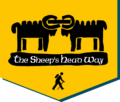Getting Here

The Sheep’s Head Way is located in South West Cork, Ireland, an hour and half drive from Cork Airport along the southern most stretch of The Wild Atlantic Way. It boast’s some of the most spectacular and unspoiled scenery in Europe and consists of over 450km of walking trails that stretch from Sheep’s Head to Gougane Barra.
The three main international airports in Ireland are Dublin, Cork, and Shannon. There are smaller airports in Kerry, Knock, Derry and Belfast. The main ferry ports are Rosslare, Dublin, Belfast and Cork.
Within Ireland there are public buses and trains. The most convenient way to get to Sheep’s Head on public transport is to fly into Cork city and then take the 236 bus from Cork bus station. From Dublin airport, there are several bus services to Cork city – Citylink and Aircoach are both popular. There is a train from Dublin to Cork as well. Outside of the main cities, public transport is limited and the most practical way to move about by car. There are limited passenger ferries into Cork, but there are cruise chips that stop in Bantry Bay on the Sheep’s Head Way.
On Sheep’s Head there is a bus (number 232) that goes from Kilcrohane to Allihies on the Beara:
link to timetable. There are also taxi’s from Bantry: link to list.
Location in West Cork

The most westerly tip of the Sheep’s Head peninsula juts out into the roaring Atlantic, sporting rugged rock, sea cliffs and expansive views. Situated between the Beara peninsula (to the north) and the Mizen Peninsula (to the south). There are three villages on the peninsula along the south coast, Kilcrohane, Ahakista and Durrus.
The walk passes through the market town of Bantry and continues to the rolling pastures of Drimoleague and Castledonovan. From there the landscape rises to over 500m above sea level, providing breathtaking views across the the bays and harbours of West Cork. This high peatland contrasts with the green and fertile Mealagh Valley, and the hilly slopes beyond Kealkill. The trail joins the Beara-Breifne way, climbing into high hill again and to the ancient monastic site at Gougane Barra.
Roads in West Cork
Examples of roads in West Cork.
The roads in West Cork range from motorway like the N71, to regional roads with minimal road markings, to unpaved narrow roads. Cork is a large county and rural areas often have limited investment in road infrastructure. This means that you will encounter narrow roads with heavy traffic and large goods vehicles.
Drivers are encouraged to take their time to enjoy the area with regular stops at appropriate locations to admire the views, take a walk or sample some local food. There are times when you’ll not see another car for miles, but it’s good practice to expect to meet large agricultural machinery, often travelling slowly. Also there will be walkers and cyclists and on occasion livestock will be using the roads too. It’s important also to be aware that local drivers may want to travel faster than visitors, so pulling over to let them pass is advised to avoid feeling under pressure on unfamiliar roads.
Roads on Sheep's Head


The Sheep’s Head peninsula can boast several “Special Protection Areas” due to the unspoilt natural environment. In keeping with this, the roads and infrastructure are not extensively or overly developed which adds to the charm and attraction for visitors. When planning your journey it is important to recognise that some roads are not suitable for buses or camper vans.
There are two main road routes extending along the peninsula. The route suitable for most vehicles travels along the coast of Dunmanus Bay on the south side, through Durrus and Ahakista to Kilcrohane.
On the “North Side” is the Goat’s Path road which travels alongside Bantry Bay. The road eventually leaves the coast and takes you up to the ridge at Seefin and then with spectacular views it descends into the village of Kilcrohane. This forms part of the Sheep’s Head Drive and the Wild Atlantic Way route but is not suitable for large vehicles.
Beyond Kilcrohane the road is less suitable for coaches and very large camper vans. For all other vehicles it is possible to travel along the Wild Atlantic Way route to the end of the road at Tooreen where there is a car park, toilets and seasonal cafe. From here the walking route will take you to the most westerly tip of the peninsula and the lighthouse.
Accommodation
This map shows the location of some accommodation options along the Sheep's Head Way.
The best way to find accommodation to to do your own online research. There is limited accommodation on Sheep's Head as the business is highly seasonal and hard to make profitable.
We list some accommodation here to get you started in your search, and they are shown as green markers in the map above.
The most general tool for finding accommodation online is Air B&B. Other possibilities are booking.com, orbitz.com or by searching for holiday homes.
We are a volunteer organisation that maintains and develops the walking trails. There was another organisation set up to promote local businesses, which may be useful for you:
https://livingthesheepsheadway.com/
You can find B&B's in Bantry listed here: link to B&B website.
In Drimoleague, you can stay at Rosalawn House B&B or the Top of the Rock Pod Park.
Below you can also scroll through the accommodation providers listed here.
The accommodation options from the map in a scroll list.
Local Festivals
There are a number of local festivals throughout the year. You can find out what's going on in Kilcrohane via the Kilcrohane Development facebook page. Every year the Ahakista Festival has a number of events, including a guided walk. There is a festival in Durrus during the summer as well.
In Bantry, you can find out about events at www.bantry.ie. In Drimoleague, there is a singing festival each year. There are other events throughout the year, such as road bowling , tractor runs, Cheval Charity Horse Ride & Drives and others.










